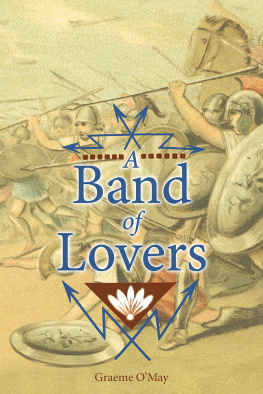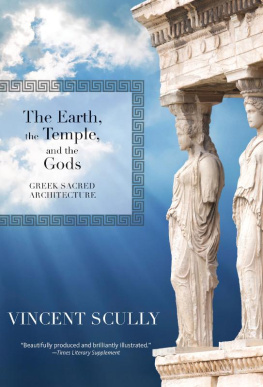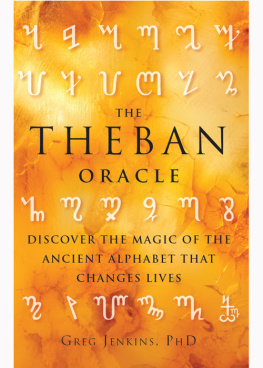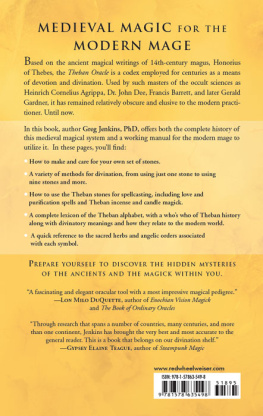James Romm - The Sacred Band: Three Hundred Theban Lovers Fighting to Save Greek Freedom
Here you can read online James Romm - The Sacred Band: Three Hundred Theban Lovers Fighting to Save Greek Freedom full text of the book (entire story) in english for free. Download pdf and epub, get meaning, cover and reviews about this ebook. year: 2021, publisher: Scribner, genre: Detective and thriller. Description of the work, (preface) as well as reviews are available. Best literature library LitArk.com created for fans of good reading and offers a wide selection of genres:
Romance novel
Science fiction
Adventure
Detective
Science
History
Home and family
Prose
Art
Politics
Computer
Non-fiction
Religion
Business
Children
Humor
Choose a favorite category and find really read worthwhile books. Enjoy immersion in the world of imagination, feel the emotions of the characters or learn something new for yourself, make an fascinating discovery.

- Book:The Sacred Band: Three Hundred Theban Lovers Fighting to Save Greek Freedom
- Author:
- Publisher:Scribner
- Genre:
- Year:2021
- Rating:5 / 5
- Favourites:Add to favourites
- Your mark:
- 100
- 1
- 2
- 3
- 4
- 5
The Sacred Band: Three Hundred Theban Lovers Fighting to Save Greek Freedom: summary, description and annotation
We offer to read an annotation, description, summary or preface (depends on what the author of the book "The Sacred Band: Three Hundred Theban Lovers Fighting to Save Greek Freedom" wrote himself). If you haven't found the necessary information about the book — write in the comments, we will try to find it.
The Sacred Band: Three Hundred Theban Lovers Fighting to Save Greek Freedom — read online for free the complete book (whole text) full work
Below is the text of the book, divided by pages. System saving the place of the last page read, allows you to conveniently read the book "The Sacred Band: Three Hundred Theban Lovers Fighting to Save Greek Freedom" online for free, without having to search again every time where you left off. Put a bookmark, and you can go to the page where you finished reading at any time.
Font size:
Interval:
Bookmark:

Three Hundred Theban Lovers Fighting to Save Greek Freedom
The Sacred Band
James Romm
Thank you for downloading this Simon & Schuster ebook.
Get a FREE ebook when you join our mailing list. Plus, get updates on new releases, deals, recommended reads, and more from Simon & Schuster. Click below to sign up and see terms and conditions.
CLICK HERE TO SIGN UP
Already a subscriber? Provide your email again so we can register this ebook and send you more of what you like to read. You will continue to receive exclusive offers in your inbox.

For Eve, Abby, and Jonah
The only general whos never been beaten is Eros.
Pammenes, leader of Thebes (as quoted by Plutarch)



Stamatakiss plan of the mass grave, with each dot standing for a member of the Sacred Band. The larger shapes at bottom are labeled by Stamatakis pieces of the lion, since the marble statue had not yet been reconstructed.
The discovery of a mass grave is a rare event in archaeology, often publicized by dramatic photographs. Yet somehow during the brief time in 1880 when the grave of the Sacred Band, at Chaeronea near Thebes, was open to view, no photos were taken. With 254 skeletons laid out in rows, this was the largest, most vivid mass burial known from the ancient world. The grave was soon covered over again, most likely forever.
The chief excavator at Chaeronea, Panagiotis Stamatakis, never published his findings, and the notebooks he had kept soon disappeared from view. While working for this book, researcher Brady Kiesling spotted a fleeting reference to these excavation notes and discovered that the archivists of the Greek Archaeological Service had located and inventoried them. We were astonished to find, as we examined them, that Stamatakis had made detailed drawings of every skeleton, marking their many wounds and fractures, and had also depicted the layout of the entire grave. With generous help from a branch of the Hellenic Ministry of Culture and Sports, the Department of Historical Archive of Antiquities and Restorations, good-quality photographs of these drawings were obtained. A selection of these are presented in this booktheir first time in print.
The final image in this series () presents a composite made by digital illustrator Markley Boyer, in which all the remains drawn by Stamatakis have been reassembled in their findspots. This painstaking work of reconstruction, based on notes and measurements found in the log, allows us to see the grave of the Sacred Band as it was laid out by the Thebans in 338 BC and as it was revealed, briefly, in 1880.
To visit Thiva in modern Greece, the site of ancient Thebes, is a lonely journey for modern tourists. Theyll likely be the only out-of-towners leaving the train there or driving up the hill of its Cadmea, the city center. Theyll find no tourist maps or postcards in its kiosks, no multilingual menus in its cafs. As they walk down the strangely named streetsPelopidas Street, Epaminondas Streettheyll have to look hard to find any trace of the citys classical past.
Meanwhile in the Plaka of Athens, a thousand T-shirts flutter on the walls of a hundred souvenir shops. The Athenian owl is seen on them in every conceivable pattern, as is the crested helmet of the Spartan infantry soldier. No icon evokes the memory of Thebes. Athens and Sparta, the antagonists of the great Peloponnesian War, loom over our imaginative landscape like twin colossi. Yet Thebes, which once held its own against those two cities combined, is nearly absent from that landscape.
The eclipse of Thebes from the modern mind would delight a man named Xenophon, an ancient Athenian soldier and essayist, who did much to bring it about. Xenophon chronicled the era of Theban greatness in his Hellenica, the sole surviving history composed in this time. But he was hardly an impartial observer. He was repelled by Thebes, since it had dared to challenge Sparta, the state he saw as Greeces natural leader. In his writings he downplayed Theban successes or, often, omitted them altogether. The single greatest triumph of Thebes over Spartaits founding of Messene, a city that sheltered Spartas escaped slavesis not even mentioned in Hellenica.
Xenophon also obscured another Theban achievement, its creation of a unique infantry corps composed of male lovers fighting in pairs. The Greeks called this corps the Sacred Band, but Xenophon refused to use that inspiring name. Instead he referred vaguely in Hellenica to the chosen men of the Thebans and mentioned them only once. He passed in silence over their first major action, a battle in which, as another historian claimed, they astonished all Greece by defeating a Spartan force that outnumbered them two to one. In another work, Symposium, Xenophon disparaged the Theban strategy of stationing lovers side by side in battle, claiming this showed only that both members were tempted to turn and run.
Fortunately Xenophons silence and scorn are partly offset by Plutarch, author of the famous Parallel Lives, a set of paired biographies contrasting Greeks and Romans. Two of those biographies concerned Theban leaders who commanded the Sacred Band and led it in its victories over Sparta. One of those two biographies, of Epaminondas, has been lost to the ravages of time, but the other, of Pelopidas, survives. Two precious paragraphs of that work describe the Band and trace its origin to 378 BC, the start of Thebess rise to superpower status. For forty years thereafter, Plutarch claimed, the Band remained undefeated in combat, until in 338 it faced an implacable foe, Alexander the Great.
Those four decadesthe age of the Sacred Band, as Ill call themare the focus of this book. These were years of crisis and decline in mainland Greece. Leadership shifted unpredictably among Athens, Sparta, and Thebes; the turbulence aided warlords and dictators in smaller cities, some of whom attained enormous strength by hiring mercenaries. War-ravaged, the Greeks sought a security framework, a Common Peace in their terms, but each of half a dozen efforts came to naught. The Great King of Persia intervened to stop the unraveling, but he himself was weakened by rebellion and palace intrigues.
Amid the confusion, democracy somehow flourished. The uniquely Greek system of assembly rule had arisen at Athens in the fifth century BC, but in the fourth it spread as never before. Hopes for Greek freedom were never higher, but dangers were never greater. The science of war was evolving, and innovations created instabilities. Philip of Macedon, father of Alexander the Great, developed new tactics that allowed him to control all of mainland Greece, but his inspiration, in part, came from the years he had spent in Thebes.
Its often said that history is written by the victors, but the case of Thebes defies that axiom. Xenophon, in Hellenica, wrote of the Theban ascendance from a Spartan viewpoint; other accounts of the era, both ancient and modern, tend to center on Athens. My admittedly narrow focus on Thebes, and on its Sacred Band, springs from my sense that little-told stories are the ones that most need to be told, especially whenas in the Theban casethe protagonists had no historians of their own.
Font size:
Interval:
Bookmark:
Similar books «The Sacred Band: Three Hundred Theban Lovers Fighting to Save Greek Freedom»
Look at similar books to The Sacred Band: Three Hundred Theban Lovers Fighting to Save Greek Freedom. We have selected literature similar in name and meaning in the hope of providing readers with more options to find new, interesting, not yet read works.
Discussion, reviews of the book The Sacred Band: Three Hundred Theban Lovers Fighting to Save Greek Freedom and just readers' own opinions. Leave your comments, write what you think about the work, its meaning or the main characters. Specify what exactly you liked and what you didn't like, and why you think so.








